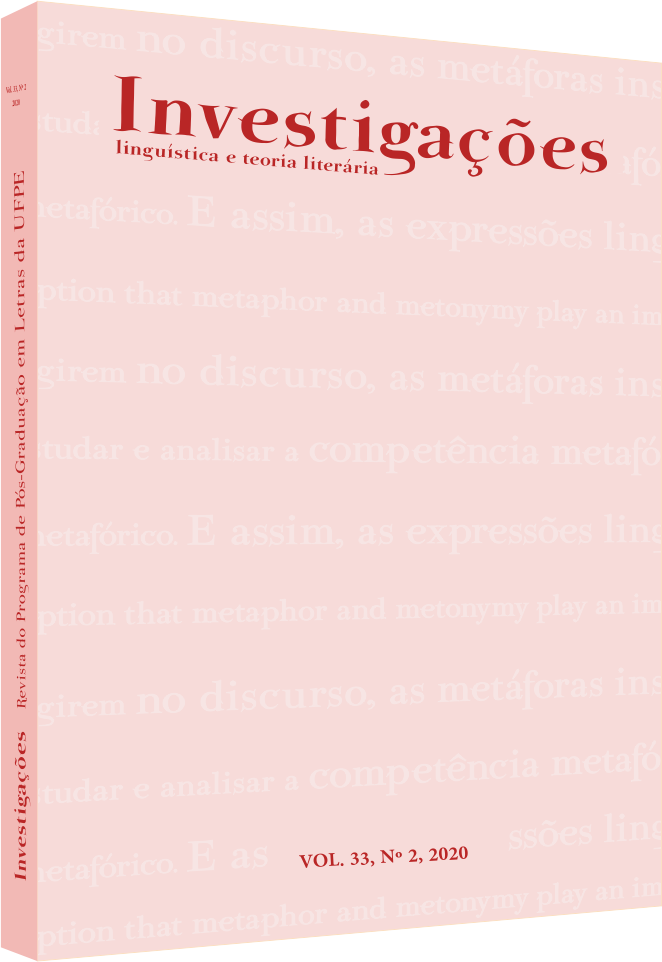O elemento gramatical “lo” em publicações didáticas brasileiras da década de 1940: Historiografia da Linguística e ensino de espanhol
DOI:
https://doi.org/10.51359/2175-294x.2020.247818Keywords:
historiography of linguistics, spanish teaching materials, forties.Abstract
Taking as object of the Historiography of Linguistics the forms of knowledge constructed about the language throughout history (ALTMAN, 2009), this article aims to analyze the metalanguage used around the grammatical element loin Spanish teaching materials published in the 1940s in Brazil. Thus, we selected five books representing that period, mainly from the publication of a law that fixed Spanish content in the Brazilian education system. The results show there is a diffuse taxonomic variety and possibilities of use of the neuter lo, which are reflected in textbooks and teaching practices up to the present.References
ALONSO, M. C. Multidimensionalidade, complexidade e dinamismo em historiografia linguística e em sua definição do conceito tradição. Todas as Letras, São Paulo, v. 14, n. 1, 2012, p. 71‐86.
ALTMAN, Cristina. Retrospectivas e perspectivas da historiografia da linguística no Brasil. Revista argentina de Historiografía Lingüística. v.1, n. 2, 2009.
AUROUX, Sylvain. A revolução tecnológica da gramatização. Campinas: Editora da Unicamp, 1992.
BARROS, Aristóteles de Paula. Español: gramática y antologia. São Paulo: Edições Melhoramentos, 1948.
BECKER, Idel. Manual de Español: gramática, história literária, antologia – curso completo para exames de licença. São Paulo: Companhia Editora Nacional, 1945.
BRASIL. MINISTÉRIO DA EDUCAÇÃO E CULTURA. Nomenclatura Gramatical Brasileira. Diário Oficial de 11/05/1959.
CELADA, María Teresa. O espanhol para o brasileiro: uma língua singularmente estrangeira. Tese (doutorado em Linguística). Universidade Estadual de Campinas, Instituto de Estudos da Linguagem, Campinas, São Paulo, 2002.
DANNA, Stela Maris Detregiacchi Gabriel. Metalinguagem e escolha de retórica em Bello (1853[1847]) e Said Ali (1919[1908]): faces dos estudos gramaticais na América do Sul. Dissertação (mestrado em Linguística). Universidade de São Paulo, Faculdade de Filosofia, Letras e Ciências Humanas, São Paulo, 2014.
ECKERT, Kleber. O artigo neutro da língua espanhola nos livros didáticos de Ensino Médio/Técnico. Língua Tec, Bento Gonçalves, v. 1, n. 1, p. 45-67, jun. 2016.
GUIMARÃES, Anselmo. Panaméricas Utópicas: a institucionalização do ensino de espanhol no Brasil (1870-1961). São Cristóvão: Editora UFS, 2016.
GUIMARÃES, Anselmo. História dos livros didáticos de espanhol publicados no Brasil (1919-1961). Tese (doutorado em Educação). Universidade Federal de Sergipe, São Cristóvão, 2018.
GUIMARÃES, Anselmo; FREITAS, Luciana Maria Almeida de. Memória do livro didático de espanhol no Brasil: um panorama. In: BARROS, Cristiano Silva de; MARINS-COSTA, Elzimar Goettenauer de; FREITAS, Luciana Maria Almeida de (Orgs.). O livro didático de espanhol na escola brasileira. Campinas: Pontes Editores, 2018.
JUCÁ FILHO, Cândico. El castellano Contemporáneo: gramática e textos. Rio de Janeiro: Editora Panamericana S/A, 1944.
KOERNER, Konrad. Questões que persistem em historiografia linguística. Revista da Anpoll, n. 2, p. 45-70, 1996.
KOERNER, Konrad. O problema da metalinguagem em historiografia da linguística. In: KOERNER, E. F. K. Quatro décadas de historiografia linguística: estudos selecionados. Trás-os-Montes e Alto Douro: Centro de Estudos em Letras, Universidade de Trás-os-Montes e Alto Douro, 2014. p. 75-90.
LAGOMARSINO, Raul Gil. Gramática Castellana: para uso nos cursos dos colégios brasileiros. Porto Alegre: A Nação, 1949 [1944]. 2a ed.
MASIP, Vicente. Origen del artículo portugués y español: aplicaciones didácticas. In: SEDYCIAS, João. O ensino de espanhol no Brasil: passado, presente, futuro. São Paulo: Parábola Editorial, 2005.
MASIP, Vicente. Gramática española para brasileños: fonología, ortografía y morfosintaxis. São Paulo: Parábola editorial, 2010.
ORLANDI, Eni. História das Ideias Linguísticas: construção do saber metalinguístico e construção da língua nacional. Mato Grosso: UNEMAT Editora, 2001.
POZO Y POZO, Adolfo. Gramática Española: para os alunos do ciclo colegial, admissão nas faculdades de Filosofia e demais escolas superiores. São Paulo: Livraria Francisco Alves, 1943.
REAL ACADEMIA ESPAÑOLA. Nueva gramática básica de la lengua española. Asociación de academias de lengua española. Barcelona: Espasa libros S.L.U, 2018.
SWIGGERS, Pierre. La historiografía de la linguística: apuntes y relfexiones. Revista argentina de historiografía linguística, I, 1, 67-76, 2009.
SWIGGERS, Pierre. Le métalangage de la linguistique: réflexions à propos de la terminologie et de la terminographie linguistiques. Revista do GEL, São Paulo, v. 7, n. 2, p. 2-29, 2010.
VIEIRA, Francisco Eduardo. A gramática tradicional: história crítica. São Paulo: Parábola Editorial, 2018.
Downloads
Published
How to Cite
Issue
Section
License
Copyright (c) 2020 Diego José Alves Alexandre, Francisco Eduardo Vieira

This work is licensed under a Creative Commons Attribution 4.0 International License.
Authors who publish with Revista Investigações agree to the following terms:
Authors retain copyright and grant the journal right of first publication with the work simultaneously licensed under the Creative Commons Attribution 4.0 International (CC BY 4.0) license that allows others to share the work with an acknowledgement of the work's authorship and initial publication in this journal.
Authors are able to enter into separate, additional contractual arrangements for the non-exclusive distribution of the journal's published version of the work (e.g., post it to an institutional repository or publish it in a book), with an acknowledgement of its initial publication in this journal.
You are free to:
Share — copy and redistribute the material in any medium or format for any purpose, even commercially.
Adapt — remix, transform, and build upon the material for any purpose, even commercially.
The licensor cannot revoke these freedoms as long as you follow the license terms.
Under the following terms:
Attribution — You must give appropriate credit , provide a link to the license, and indicate if changes were made . You may do so in any reasonable manner, but not in any way that suggests the licensor endorses you or your use.
No additional restrictions — You may not apply legal terms or technological measures that legally restrict others from doing anything the license permits.

